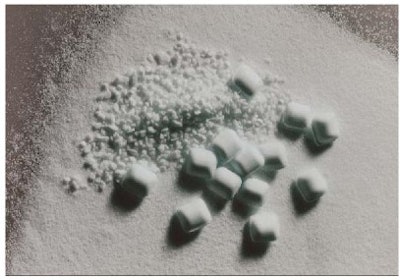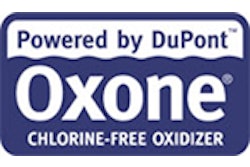
Salt has many uses around the house. Besides enhancing baked potatoes, making bland burgers better and coating the rims of margarita glasses, it can be employed in gargling, stain-removal and de-icing the driveway. Historically it's been used as currency, its taxation financed the building of the Erie Canal, and it's one of the most effective food preservatives in the world. There's even a Salt Institute, which is dedicated to spreading the word about salt's illustrious history and "14,000 uses." Your grandmother probably knew most of those uses, but she probably didn't know it could be used to make chlorine for pools.
Dealers and builders trying to sell salt water chlorinators may come up against customers who don't know any more about salt chlorinators than your grandmother did. "So the pool will be filled with salt water. Like the ocean. Hmmm. That's fine for body surfing and all, but I don't know . . ." Others may have heard about them, but not knowing how they operate, they're not sure if they should buy one.
In an effort to clear things up, AQUA spoke with several manufacturers of salt water chlorinators about how they work, why they're a good thing for both dealers and consumers, and what the Aussies know about them that most Americans don't.
The Process
Simply put, salt chlorinators turn salt water into chlorine to sanitize swimming pool water. They're made by many manufacturers, but all the devices work on the exact same principal.
"A charge of electricity is put into the saline solution [in the cell] via the anodes and electrodes," says Roger Hampson-Taylor, co-owner of Environmental Pool Systems/POOL THING in Scottsdale, Ariz. "This disturbs the molecular balance of the saline solution and in doing so creates the required sanitizer and oxidizer."
What that means to consumers is they no longer have to deal with chlorine in the ways they're accustomed to: no more purchasing, transporting, storing or handling a potentially dangerous chemical.
While the prospect of not dealing with liquid or granular chlorine will certainly appeal to some customers, manufacturers point to a number of other attractive benefits, including the soft feel of the water, the lack of odor, and easiness on the eyes.
"The major scientific benefit offered by salt water chlorination in the sanitizing process is that not only is there a sanitizing action in the swimming pool resulting from the free chlorine residual in the water, but there is a far more powerful sanitizing action which takes place in the cell itself," says Michael Gregg, director of marketing for Zodiac Pool Care, Pompano Beach, Fla.
This is important, Gregg explains, because contaminants like lotions and body oils are attacked both by the chlorine and by the electrolysis in the cell of the generator, thus helping to keep chloramines from forming. And as any pool chemist will tell you, it's chloramines, not chlorine itself, that cause odor, red eyes and skin irritation.
Initial Cost
The cost of a salt generator — roughly between $1,000 and $1,600 — will of course factor into the customer's buying decision, and it's of note to dealers, too, who understand that selling what amounts to a chlorine factory means those customers won't be coming into the store to buy it anymore.
"The capital outlay will be recovered on a residential pool in two to four years, depending on the bather load and sanitization and oxidization demands of the pool," Hampson-Taylor says. "Quite often purchase decisions are made on that financial consideration. But generally they're made on the feel of the water."
As suppliers point out, dealers, then, stand to get up-front the money customers would be spending on chlorine over that period of time.
"If it's a standard chlorinator sale, the dealer profits from the sale and gets future years' margins all at once," Gregg explains. "There's also the opportunity for replacement electrode sales in three to five years."
Marty Fisher, national sales manager for Balboa Direct/Eco-Matic Salt Water Pool Systems in Tustin, Calif., says his company's cells last an average of 10,000 hours, and once their useful life ends, changing them out simply involves unthreading them, unplugging the probe and replacing it with a new one. He, too, thinks dealers would benefit financially by selling salt water chlorinators.
"Once dealers are shown the profit potential on these systems compared to the profit potential for chemical sales, they'll stop worrying [about losing chlorine sales]," Fisher says. "And taking into consideration that mass merchants are selling chlorine — at very low margins — dealers are much better off selling salt water systems."
Service technicians are also sometimes hesitant to tell people about salt water chlorinators for fear of losing business. Such fears are unfounded, says Richard Varley, president of Watermaid USA, a Sarasota, Fla.-based company that distributes the Australian brand of the same name. "They think they're going to lose their jobs, but all the salt generator does is make chlorine," he says. "But when you think about it, there's less chemical wear on their trucks, their clothing and so forth. It actually makes their business more profitable and their job easier."
Market Penetration
The size of the salt chlorination market in the United States is admittedly small, but it's growing. Insiders estimate that between 5 and 15 percent of new pools are built with a salt chlorinator, but a look at the other side of the world reveals the category's boundless potential. In Australia, where scores of companies manufacture them, as many as 90 percent of residential pools are chlorinated through salt generation.
Perhaps the market would be closer to maturity in the United States had the product been marketed differently the first time it was introduced, back in the late '70s and early '80s, when many dealers hyped them as "maintenance-free" or "chemical-free" systems.
"They were even sold as 'all-natural.' But customers still have to add stabilizer, muriatic acid, etc.," Fisher explains. "So people were selling it under all kinds of misconceptions. Our basic challenge as an industry is to teach people about it and to dispel any of those misconceptions."
Additionally, the salt water generators of a quarter century ago had some safety issues, according to Fisher. "I mean, these systems make chlorine gas, and that's a dangerous substance," he says. "In the early days there were some issues with that, but today, with the technology that's being used, there are no longer those problems. It's an extremely safe system. And the cost has come down to the point where they're affordable to anyone with a pool."
Market Maturity
In order to tap into the salt water chlorinator's potential, the industry needs to be honest about the maintenance involved and sell the product on its benefits, manufacturers say.
Trying to claim they'll eliminate or virtually eliminate maintenance will lead to disappointed customers and lost referrals. Salt water chlorinators don't need to be maintenance free — they've got enough benefits to tout without stretching the truth. So what, then, does a homeowner need to do.
"He needs to make sure the pool is operating properly, and that means keeping it clean," says HampsonTaylor. "He'll also need to be involved in the balance of the water, and that means the pH, total alkalinity and the hardness."
Failure to follow these steps can lead to a malfunctioning salt water chlorinator, which is usually unfairly blamed on the unit and not the imbalanced water.
"You'll find people say, 'My chlorinator's gone wrong.' Guess what? The real reason is that the chemistry is off," Hampson-Taylor adds. "The hardness, the water table, the propensity of nitrates and phosphates to get into pool water, all of these things have an impact on water chemistry, which in turn can affect the operation. It's not like other pool equipment. A pump doesn't care. It sucks water in one side and blows it out the other. But a salt water chlorinator is different, and this can make people misunderstand."
Gregg agrees: "Salt water chlorinators are not meant to be 'no-maintenance' products, and they still require proper water balance and occasional maintenance, just like most other appliances that bring automation into our lives," he explains.
Though all major salt chlorinators today feature reverse polarity, in which the anodes and cathodes switch electrical charges back and forth periodically, thus "shedding" anything that may accumulate on the metal plates, parts of the plates are still subject to calcium buildup.
"Because polarity is spherical and the plates are rectangular, the very ends of the cell don't necessarily shed calcium, so they do require cleaning," Fisher says. "Our cell is removable from the housing, so instead of having to dip the entire housing and cell into an acid solution, you can remove the cell from the housing and dip that in."
Another feature that helps people maintain the units is see-through housing, which allows both homeowners and service techs to see calcium buildup on the cell before it becomes a major issue and clogs the entire system.
The Future
Back to Australia. If the product is so prevalent there, why is it only found on about one in 10 pools here. The simple answer is lack of awareness, according to manufacturers.
"Consumers in some markets, like Phoenix, California and Florida are somewhat aware due to the volume of SWC (salt water chlorinator) systems that builders are installing in new pools," Gregg says. "Word of mouth at the consumer level is very big with this category and it's helping put a positive spin on the benefits of the systems."
Gregg, for his part, thinks the current market penetration is about 30 percent of new in-ground pools. "That rate is increasing yearly," he says. "It could reach 50 percent in a couple of years and head toward 70 percent in a few more years."
And the reason for this optimism? According to Hampson-Taylor, one need only look to the industry's recent spate of buyouts and mergers for evidence that manufacturers see a very bright future in salt.
"That's why Hayward bought Goldline. They see the potential," Hampson-Taylor says. "Want more examples? Zodiac acquired ClearWater, an Aussie brand, a couple of years ago. Water Pik acquired Huron Tech. Pentair has control of Kreepy Klear. The list goes on and on. Why would America not follow Australia."
What About Hot Tubs?
Most pool professionals know that the water in hot tubs is too hot to be sanitized with chlorine. That's because chlorine gasses off at temperatures above 96 degrees Fahrenheit, making it very difficult to maintain a reliable chlorine residual. Bromine, on the other hand, is widely used and effective in hot tubs, but not in pools.
"In swimming pools, it's really not advisable that you use bromine from bromide salt because bromades can be formed [due to sunlight], and bromades are bad," says Paul Birkbeck of Pioneer H2O Technologies in Lakewood, Colo., which makes the Genesis Device. "In hot tubs, you don't have the presence of sunlight, because residential hot tubs are covered 99 percent of the time. Additionally, people don't drink the water in a hot tub, which is the only way the bromades would be an issue."
Hot tubs have their own salt generators, but instead of using sodium hypochloride, they use bromide salt.
"Chlorine generation and bromine generation utilize the exact same principles," Birkbeck says. "The reservoir is doped with salt, which is then converted into a sanitizer through electrolysis. Once it's performed its function, it's converted back to salt, then back to sanitizer, then back to salt, perpetually. The only difference between the two is what I call the precursor. A salt chlorine generator utilizes NaCl, and a bromine generator utilizes NaBr."
—B.K.
Does the Water Taste Salty?
Some people may have the misconception that a salt pool will feel and taste salty. Their point of reference is ocean water, which is fun for body surfing but can be a bit irritating to skin and eyes. In reality, though, the level of salt in a salt chlorine pool is a small fraction of what's found in sea water.
According to Roger Hampson-Taylor, co-owner of Environmental Pool Systems/POOL THING in Scottsdale, Ariz., the level of salt in the ocean is 36,000 parts per million, and that's extremely noticeable. A teardrop is about 8,000 ppm — still sort of salty. The water in a salt water pool, on the other hand, ranges from 2,500 to 4,000 ppm. "It's barely discernable," he says.
—B.K.











































